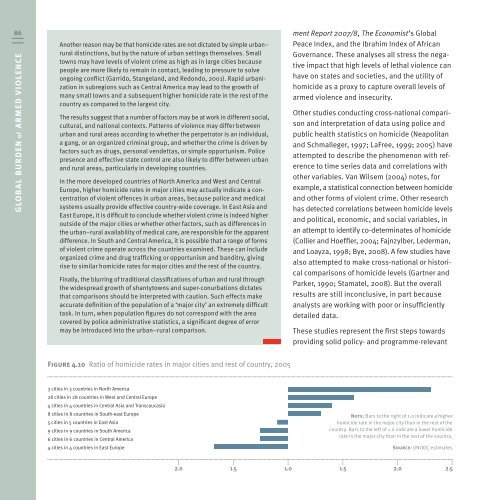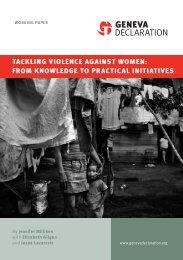Global Burden of Armed Violence - The Geneva Declaration on ...
Global Burden of Armed Violence - The Geneva Declaration on ...
Global Burden of Armed Violence - The Geneva Declaration on ...
You also want an ePaper? Increase the reach of your titles
YUMPU automatically turns print PDFs into web optimized ePapers that Google loves.
86 ment Report 2007/8, <str<strong>on</strong>g>The</str<strong>on</strong>g> Ec<strong>on</strong>omist’s <str<strong>on</strong>g>Global</str<strong>on</strong>g><br />
GLOBAL BURDEN <str<strong>on</strong>g>of</str<strong>on</strong>g> ARMED VIOLENCE<br />
Another reas<strong>on</strong> may be that homicide rates are not dictated by simple urban–<br />
rural distincti<strong>on</strong>s, but by the nature <str<strong>on</strong>g>of</str<strong>on</strong>g> urban settings themselves. Small<br />
towns may have levels <str<strong>on</strong>g>of</str<strong>on</strong>g> violent crime as high as in large cities because<br />
people are more likely to remain in c<strong>on</strong>tact, leading to pressure to solve<br />
<strong>on</strong>going c<strong>on</strong>flict (Garrido, Stangeland, and Red<strong>on</strong>do, 2001). Rapid urbanizati<strong>on</strong><br />
in subregi<strong>on</strong>s such as Central America may lead to the growth <str<strong>on</strong>g>of</str<strong>on</strong>g><br />
many small towns and a subsequent higher homicide rate in the rest <str<strong>on</strong>g>of</str<strong>on</strong>g> the<br />
country as compared to the largest city.<br />
<str<strong>on</strong>g>The</str<strong>on</strong>g> results suggest that a number <str<strong>on</strong>g>of</str<strong>on</strong>g> factors may be at work in different social,<br />
cultural, and nati<strong>on</strong>al c<strong>on</strong>texts. Patterns <str<strong>on</strong>g>of</str<strong>on</strong>g> violence may differ between<br />
urban and rural areas according to whether the perpetrator is an individual,<br />
a gang, or an organized criminal group, and whether the crime is driven by<br />
factors such as drugs, pers<strong>on</strong>al vendettas, or simple opportunism. Police<br />
presence and effective state c<strong>on</strong>trol are also likely to differ between urban<br />
and rural areas, particularly in developing countries.<br />
In the more developed countries <str<strong>on</strong>g>of</str<strong>on</strong>g> North America and West and Central<br />
Europe, higher homicide rates in major cities may actually indicate a c<strong>on</strong>centrati<strong>on</strong><br />
<str<strong>on</strong>g>of</str<strong>on</strong>g> violent <str<strong>on</strong>g>of</str<strong>on</strong>g>fences in urban areas, because police and medical<br />
systems usually provide effective country-wide coverage. In East Asia and<br />
East Europe, it is difficult to c<strong>on</strong>clude whether violent crime is indeed higher<br />
outside <str<strong>on</strong>g>of</str<strong>on</strong>g> the major cities or whether other factors, such as differences in<br />
the urban–rural availability <str<strong>on</strong>g>of</str<strong>on</strong>g> medical care, are resp<strong>on</strong>sible for the apparent<br />
difference. In South and Central America, it is possible that a range <str<strong>on</strong>g>of</str<strong>on</strong>g> forms<br />
<str<strong>on</strong>g>of</str<strong>on</strong>g> violent crime operate across the countries examined. <str<strong>on</strong>g>The</str<strong>on</strong>g>se can include<br />
organized crime and drug trafficking or opportunism and banditry, giving<br />
rise to similar homicide rates for major cities and the rest <str<strong>on</strong>g>of</str<strong>on</strong>g> the country.<br />
Finally, the blurring <str<strong>on</strong>g>of</str<strong>on</strong>g> traditi<strong>on</strong>al classificati<strong>on</strong>s <str<strong>on</strong>g>of</str<strong>on</strong>g> urban and rural through<br />
the widespread growth <str<strong>on</strong>g>of</str<strong>on</strong>g> shantytowns and super-c<strong>on</strong>urbati<strong>on</strong>s dictates<br />
that comparis<strong>on</strong>s should be interpreted with cauti<strong>on</strong>. Such effects make<br />
accurate definiti<strong>on</strong> <str<strong>on</strong>g>of</str<strong>on</strong>g> the populati<strong>on</strong> <str<strong>on</strong>g>of</str<strong>on</strong>g> a ‘major city’ an extremely difficult<br />
task. In turn, when populati<strong>on</strong> figures do not corresp<strong>on</strong>d with the area<br />
covered by police administrative statistics, a significant degree <str<strong>on</strong>g>of</str<strong>on</strong>g> error<br />
may be introduced into the urban–rural comparis<strong>on</strong>.<br />
Figure 4.10 Ratio <str<strong>on</strong>g>of</str<strong>on</strong>g> homicide rates in major cities and rest <str<strong>on</strong>g>of</str<strong>on</strong>g> country, 2005<br />
3 cities in 3 countries in North America<br />
28 cities in 28 countries in West and Central Europe<br />
4 cities in 4 countries in Central Asia and Transcaucasia<br />
8 cities in 8 countries in South-east Europe<br />
5 cities in 5 countries in East Asia<br />
9 cities in 9 countries in South America<br />
6 cities in 6 countries in Central America<br />
4 cities in 4 countries in East Europe<br />
Peace Index, and the Ibrahim Index <str<strong>on</strong>g>of</str<strong>on</strong>g> African<br />
Governance. <str<strong>on</strong>g>The</str<strong>on</strong>g>se analyses all stress the negative<br />
impact that high levels <str<strong>on</strong>g>of</str<strong>on</strong>g> lethal violence can<br />
have <strong>on</strong> states and societies, and the utility <str<strong>on</strong>g>of</str<strong>on</strong>g><br />
homicide as a proxy to capture overall levels <str<strong>on</strong>g>of</str<strong>on</strong>g><br />
armed violence and insecurity.<br />
Other studies c<strong>on</strong>ducting cross-nati<strong>on</strong>al comparis<strong>on</strong><br />
and interpretati<strong>on</strong> <str<strong>on</strong>g>of</str<strong>on</strong>g> data using police and<br />
public health statistics <strong>on</strong> homicide (Neapolitan<br />
and Schmalleger, 1997; LaFree, 1999; 2005) have<br />
attempted to describe the phenomen<strong>on</strong> with reference<br />
to time series data and correlati<strong>on</strong>s with<br />
other variables. Van Wilsem (2004) notes, for<br />
example, a statistical c<strong>on</strong>necti<strong>on</strong> between homicide<br />
and other forms <str<strong>on</strong>g>of</str<strong>on</strong>g> violent crime. Other research<br />
has detected correlati<strong>on</strong>s between homicide levels<br />
and political, ec<strong>on</strong>omic, and social variables, in<br />
an attempt to identify co-determinates <str<strong>on</strong>g>of</str<strong>on</strong>g> homicide<br />
(Collier and Hoeffler, 2004; Fajnzylber, Lederman,<br />
and Loayza, 1998; Bye, 2008). A few studies have<br />
also attempted to make cross-nati<strong>on</strong>al or historical<br />
comparis<strong>on</strong>s <str<strong>on</strong>g>of</str<strong>on</strong>g> homicide levels (Gartner and<br />
Parker, 1990; Stamatel, 2008). But the overall<br />
results are still inc<strong>on</strong>clusive, in part because<br />
analysts are working with poor or insufficiently<br />
detailed data.<br />
<str<strong>on</strong>g>The</str<strong>on</strong>g>se studies represent the first steps towards<br />
providing solid policy- and programme-relevant<br />
Note: Bars to the right <str<strong>on</strong>g>of</str<strong>on</strong>g> 1.0 indicate a higher<br />
homicide rate in the major city than in the rest <str<strong>on</strong>g>of</str<strong>on</strong>g> the<br />
country. Bars to the left <str<strong>on</strong>g>of</str<strong>on</strong>g> 1.0 indicate a lower homicide<br />
rate in the major city than in the rest <str<strong>on</strong>g>of</str<strong>on</strong>g> the country.<br />
Source: UNODC estimates<br />
2.0 1.5 1.0 1.5 2.0 2.5









